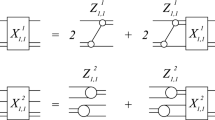Abstract
We start with an assumed shape for the wavefunction of the ground state of the two-nucleon system. This wavefunction gives us the residue of thet-matrix at the bound-state pole-and using the unitary pole approximation (UPA) provides a good extrapolation procedure for other off-shell values of thet-matrix. (E. Harms has verified the accuracy of the UPA using the anti-bound state for theReid soft-core singlet potential.)
We now face the problem: what bound-state wavefunction should we assume? In the next several years it should be possible to determine the deuteron wavefunction experimentally, by measuring elastic electron-deuteron scattering from polarized deuterons, or equivalently by measuring the polarization of the recoil deuteron. (The wavefunction at large neutron-proton separation should also be checked by using it in the Schrödinger equation to give a local potential which should agree well with that for one pion exchange.) Angular distribution measurements provide a separation of the deuteron form factor into a charge form factor and a magnetic moment form factor. Polarization measurements separate the charge form factor into a monopole form factorG 0 and a quadrupole form factorG 2.T. Brady has found that values ofG 2(q) at momentum transfersq of order 3F −1 are quite sensitive to the percentage ofD-state (p D) in the deuteron. At present the lack of knowledge ofpD is the main source of uncertainty in calculation of the energy of the trinucleon.
Резюме
Сначала предлагаем определенную форму волновой функции основного состояния системы двух ядер. Эта волновая функция дает остатокt-матрицы в полюсе связанного состояния, и использование приближения единичного полюса дает хорошую экстраполяцию для значенийt-матрицы в неэнергетической поверхности. Сейчас возникает проблема, какую волнову функцию связанного состояния мы должны подобрать? В течение следующих лет становится возможным экспериментальным путем определить волновую функцию дейтерия путем измерения упругого рассеяния электрона и действия в поляризованном дейтерии или аналогичным путем измерить поляризацию отраженного дейтерия.
Similar content being viewed by others
References
J. Levinger et al., Phys. Rev.,179, 926, 1969.
Y. Yamaguchi, Phys. Rev.,95, 1628, 1954.
E. Harms, Phys. Rev.,C1, 1667, 1970.
E. Lomon, Comments Nucl. Part. Phys.,4, 28, 1970.
H. Feshbach andA. K. Kerman, Comments Nucl. Part. Phys.,2, 22 and2, 78, 1968.
R. D. Amado, Phys. Rev.,C2, 2439, 1970.
M. Baranger et al., Nucl. Phys.,A138, 1, 1969.
W. Van Dijk andM. Razavy, Nucl. Phys.,A159, 161, 1970.
M. G. Fuda, Nucl. Phys.,A130, 155, 1969.
M. G. Fuda, Phys. Rev.,C3, 55 andC3, 485, 1971.
K. L. Kowalski et al., Phys. Rev.,C3, 1146, 1971.
M. I. Haftel, Phys. Rev. Lett.,25, 120, 1970.
R. V. Reid, Annals Phys. (N. Y.),50, 411, 1968.
R. A. Malfliet andJ. A. Tjon, Annals Phys., (N. Y.)61, 425, 1970.
C. Lovelace, Phys. Rev.,135B, 1225, 1964.
M. G. Fuda, Nucl. Phys.,A116, 83, 1968.
E. Harms andL. Laroze, Nucl. Phys.,A160, 449, 1970.
C. Burnap et al., Phys. Lett.,33B, 337, 1970.
L. P. Kok et al., Nucl. Phys.,A122, 684, 1968.
D. D. Brayshaw, Phys. Rev.,C3, 35, 1971.
T. Brady, Dissertation, Rensselaer Polytechnic Institute, 1969.
S. Bhatt et al., Bull. Amer. Phys. Soc.,16, 559, 1971.
M. H. MacGregor et al., Phys. Rev.,182, 174, 1969.
T. R. Mongan, Phys. Rev.,178, 1597, 1969.
N. K. Glendening andG. Kramer, Phys. Rev.,126, 2159, 1962.
R. Mehrotra andK. S. Gupta, Phys. Rev.,D1, June 15, 1970.
R. R. Wilson andJ. S. Levinger, Ann. Revs. Nucl. Sci.,14, 135, 1964.
R. Prepost et al., Phys. Rev. Lett.,21, 1271, 1968.
Gourdin andPiketti, Nuovo Cim., 1963;Gourdin, book on electron scattering, 1964.
A. D. Jackson andJ. A. Tjon, Phys. Lett.,32B, 9, 1970.
J. A. Tjon et al., Phys. Rev. Lett.,25, 540, 1970.
R. Blancenbecler andJ. V. Gunion, Phys. Rev. D. in press, 1971.
Author information
Authors and Affiliations
Additional information
Travel supported in part by the National Science Foundation.
Rights and permissions
About this article
Cite this article
Levinger, J.S. “How can we determine the two-bodyt-matrix?”. Acta Physica 33, 135–150 (1973). https://doi.org/10.1007/BF03158002
Issue Date:
DOI: https://doi.org/10.1007/BF03158002



